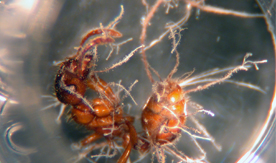
UMaine Researchers Explore Using a Newly Discovered Pathogenic Fungus to Scale Back Invasive Fire Ant Populations in Maine
University of Maine researchers are one step closer to controlling the ever-growing invasive fire ant populations, Myrmica rubra, that have been spreading throughout Maine for the last 15 years.
Due to the highly competitive and aggressive behavior of these fire ants, eradication has proven to be almost impossible. UMaine researchers are turning their attention to a different kind of control to try and combat these tiny stinging insects. Their weapon — pathogenic fungi.
“We are attempting to try and grow this newly discovered fungi in the lab in order to look at its utility for management of the ants, but it may be too difficult to reproduce which would hamper its development as a biological control mechanism. We aren’t convinced, but we are looking into it,” said Eleanor Groden, UMaine professor of biological sciences. “It has some potential.”
By encouraging the growth of the pathogenic fungi, these researchers hope to scale down the populations of invasive fire ants, which will alleviate Maine residences from the painful stings the tiny insects administer.
In an article that appeared in the Journal of Invertebrate Pathology, titled “Ophiocordyceps myrmicarum, a new species infecting invasive Myrmica rubra in Maine” researchers Rabern Simmons (now at the School of Forest Resources and Conservation at the University of Florida), Groden, Jennifer Lund and Tamara Levitsky isolated and described a newly discovered fungus which they identified as being a member of the genus Hirsutella. The fungi is the first species in this genus to be isolated from the North American European fire ant in New England, though there are two other pathogens within the genus which infect M. rubra in the United Kingdom.
The researchers suspect that the relatedness of the taxa infers that O. myrmicarum is a native of North America or a relatively recent immigrant along with the invasive European fire ant. They also hypothesize that the dramatic increase in fire ant populations over the last decade could be causing increased transmission of the fungi and could explain why we have only observed the fungi in Maine, not in European ant populations.
Ants were collected live from Acadia National Park near Breakneck Ponds, Mount Desert Island, in fall 2010 and 2011. The researchers isolated and maintained the ants in cultures in order to collect morphological data. They then used techniques such as DNA extraction, amplification, sequencing and phylogenetic analysis to determine if it was, in fact, a new species.
The researchers conducted an exposure trial in seven separate chambers, four of which were inoculated with the fungi. Of the four chambers exposed with O. myrmicarum, all individuals died within 30 days, whereas no ants in the remaining three chambers died during the same period. Once dead, the infected ants were transferred to well plates to be monitored for several weeks, during which 20 of the 73 dead ants produced the reproductive structure of the fungal pathogen.
The exotic ant species was first documented in New England in the early 1900s. According to the researchers, the native populations — ranging from Great Britain to Siberia and the Black Sea to the Arctic — remain relatively low in population density. But in New England and other various locations throughout North America, the population density is high for the invasive species.
“There are a lot of steps between what we are doing and determining if a strategy like this would be viable. But, it’s very exciting,” said Groden.
Contact: Amanda Clark, 207.581.3721
Photo courtesy of Jennifer Lund
